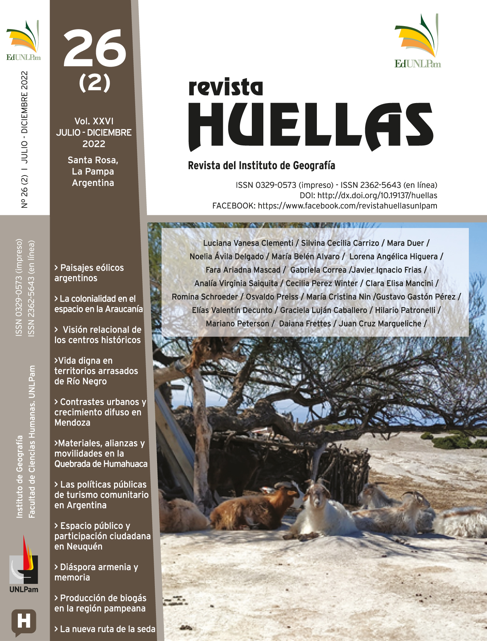Coloniality in the space. A revision of spatial order in Araucania after land besiege in the South of Chile
DOI:
https://doi.org/10.19137/huellas-2022-2615Keywords:
reservations, Coloniality, rurality, spatial orderingAbstract
This article presents a history of land governance since the implementation of Indian reservations, known as indian removals, during the conquest of Araucanía, Chile. By applying a relational and conflict approach to land relations, the article retrieves historical forms of land reservation and their technological developments to historicize the ways in which modern-colonial rurality has developed to the present day in the Central-Southern region of Chile. The article concludes with the analysis of the emerging technologies of spatial ordering where I argue that a new regime of disciplinary ordering is developing using the plantations themselves as a means to govern space. The result is the undermining of the role of people as “inhabitants” in the assemblage with the modern territorial state. This research is based on a qualitative and interpretative analysis of data collected during the fieldwork (August to October 2014 and November 2015 to March 2016) conducted in Araucanía, Chile.
Downloads
References
Aravene, A. (2002). “Los Mapuche-Warriache: migración e identidad Mapuche urbana en el siglo XX” (359-387). En Boccarra, G. (ed.). Colonización, Resistencia y Mestizaje en las Américas (Siglos XVI-XX) Quito: Ediciones Abya-Yala.
Bagge, M. L.S. (2014). Valuable ally or invading army? The ambivalence of gorse in New Zealand. ENNZ, Vol9 no1, Australian and New Zealand Environmental history network, 1835-1900. http://environmentalhistory-au-nz.org/2014/03/valuable-ally-or-invading-army-the-ambivalence-of-gorse-in-new-zealand-1835-1900/
Calbucura, J., et. al. (1996). Fronteras, Etnias, Culturas. América Latina, Siglos XVI-XX. http://urn.kb.se/resolve?urn=urn:nbn:se:uu:diva-30696
Casanueva, F. (2002). “Indios malos en tierras buenas: vision y concepción del mapuche según las elites chilenas” (291-328), siglo XIX. En Boccarra, G. (ed.). Colonización, Resistencia y Mestizaje en las Américas (Siglos XVI-XX) Quito: Ediciones Abya-Yala.
Correa, M. (2014). La Comunidad Autónoma Mapuche Miguel Huentelen: Su Historial. Investigación comunitaria. Disponible a requerimiento del autor.
Correa, M. (2021). Historia del despojo. El origen de la propiedad particular en el territorio Mapuche. Santiago: Pehuén Editores-Ceibo Editores.
Cusicanqui, S. R. (2010). Violencias (re) encubiertas en Bolivia. La Paz: Editorial Piedra Rota.
Duer, M, & Vegliò, S. (2019). Modern-colonial geographies in Latin America: The mirage of the civilizing city and the archaic countryside. Journal of Latin American Geography, 18(3), 11-29. DOI: https://doi.org/10.1353/lag.2019.0058
Durkheim, E. (1984). The Division of Labour in Society. Basingstoke: Macmillan.
Elden, S. (2010). Land, terrain, territory. Progress Human Geography 34(6), 799-817: DOI: https://doi.org/10.1177/0309132510362603
Gay, C. (1862). Historia Física y Política de Chile. Agricultura, 1er Tomo. En casa del autor.
Paris. Chile, en el Museo de Historia Natural de Santiago. http://www.memoriachilena.cl/602/w3-article-7878.html
Gudynas, E. (2010). La ecología política de la crisis global y los límites del capitalismo benévolo. Íconos-Revista de Ciencias Sociales, (36), 53-67.
González Casanova, P. (2006). “El colonialismo interno” (185-205). En González Casanova, P. Sociología de la explotación. Buenos Aires: CLACSO, Consejo Latinoamericano de Ciencias Sociales,. http://bibliotecavirtual.clacso.org.ar/ar/libros/secret/gonzalez/colonia.pdf
Global Invasive Species Database (2013). Ulex europaeus. Disponible en http://www.issg.org/database/species/ecology.asp?si=69&fr=1&sts=&lang=EN (Consulta 12/04/ 2015).
Harvey, D. (2001). Globalization and the “spatial fix”. geographische revue: Zeitschrift für Literatur und Diskussion, 3(2), 23-30. https://d-nb.info/1217929630/34
Harvey, C. A., C. Villanueva, J. Villacís, M. Chacón, D. Muñoz, M. López, M. Ibrahim, R. Taylor, J. Martínez, A. Navas, J. Sáenz, D. Sánchez, A. Medina, S. Vílchez, B. Hernández, A. Pérez, F. Ruiz, F. López, I. Lang y F. L. Sinclair. (2005). Contribution of live fences to the ecological integrity of agricultural landscapes. Agriculture, ecosystems & environment, 111(1-4), 200-230. DOI: https://doi.org/10.1016/j.agee.2005.06.011
Hornoy, B., Atlan, A., Roussel, V., Buckley, Y. M., & Tarayre, M. (2013). Two colonisation stages generate two different patterns of genetic diversity within native and invasive ranges of Ulex europaeus. Heredity, 111(5), 355-363. DOI: https://doi.org/10.1038/hdy.2013.53
Lefebvre H. (2003). Key Writings. London: Continuum.
Li, T. M. (2011). Centering Labor in the Land Grab Debate. Journal of Peasant Studies 38(2), 281-298. DOI: https://doi.org/10.1080/03066150.2011.559009
Li, T. M. (2010). To make live or let die? Rural dispossession and the protection of surplus populations. Antipode, 41, 66-93. DOI: https://doi.org/10.1111/j.1467-8330.2009.00717.x
Moore, J. (2016). "The Rise of Cheap Nature" (78-115). Sociology Faculty Scholarship. 2. En Moore, J Anthropocene or Capitalocene?, Oakland: PM Press. https://orb.binghamton.edu/sociology_fac/2
Muñoz, E. (2009). El espinillo (Ulexeuropaeus L. 1753): un invasor biológico en el sur de chile: estado de su conocimiento y alternativas de control. Gestión Ambiental, 17, 23-44. http://ceachile.cl/revista/cdn/GA_17_Munoz.pdf.
Netz, R. (2004). Barbed Wire, an ecology of modernity. Durham: Wesleyan University Press.
Pinto, J. R. (2002). “Las heridas no cicatrizadas.”(329-358) En Boccarra, G. (ed.). Colonización, Resistencia y Mestizaje en las Américas (Siglos XVI-XX) Quito: Ediciones Abya-Yala.
Rovere, A. E., Molares, S., & Ladio, A. H. (2013). Plantas utilizadas en cercos vivos de ciudades patagónicas: aportes de la etnobotánica para la conservación. Ecología austral, 23(3), 165-173. DOI: https://doi.org/10.25260/EA.13.23.3.0.1171
Sbarra, N. H. (1964). Historia del alambrado en la Argentina. Buenos Aires: Eudeba, Editorial Universitaria de Buenos Aires.
Sevilla‐Buitrago, A. (2015). Capitalist formations of enclosure: Space and the extinction of the commons. Antipode, 47(4), 999-1020. DOI: https://doi.org/10.1111/anti.12143
Sevilla-Buitrago, A. (2012). Territory and the governmentalisation of social reproduction: parliamentary enclosure and spatial rationalities in the transition from feudalism to capitalism. Journal of Historical Geography, 38(3), 209-219. DOI: https://doi.org/10.1016/j.jhg.2012.02.002
Silveira, M. L. (2006). Los territorios corporativos de la Geograficando, 3(3), 13-26. http://sedici.unlp.edu.ar/handle/10915/13941
Quijano, A. (2010). “Coloniality and modernity/rationality” (22-33) en Mignolo, W. D., & Escobar, A. (Eds.). Globalization and the decolonial option. London and New York: Routledge.
Klubock, T. M. (2014). La Frontera : forests and ecological conflict in Chile's frontier territory. Durham: Duke University Press.
Sokoloff, K. L., & Engerman, S. L. (2000). Institutions, factor endowments, and paths of development in the new world. Journal of Economic perspectives, 14(3), 217-232. https://www.aeaweb.org/articles?id=10.1257/jep.14.3.217
Wood Meiksins, E. (2002) The Origin of Capitalism, London: Verso.










.png)












3.jpg)


